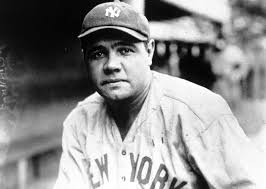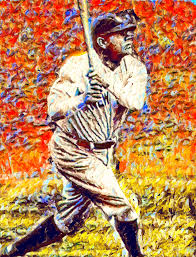BIOPICS, BASEBALL AND BALDERDASH
BIOPICS, BASEBALL AND BALDERDASH
with Norman Warwick
Nobody expects biopics to be great, proclaimed Kayleigh Donaldson in a recent edition of the admirable Paste magazine. In an article that, otherwise, literally knocked it out of the park she unfortunately stepped on my dreams.
She made no concessions to a 12 year old boy who, sixty years ago at the time he first saw the biopic the Paste journalist was discussing still did expect biopics to be great. Not that I can remember any other biopics I had seen at the time and I certainly didn´t expect the first one I would see would be in grainy black and white, which was also the format of my family´s telly at the time. If my memory serves me right (and of course biopics and temporal accuracy do not always run parallel) I wanted to watch the film, already in its severalth repeat, to learn more about this great sportsman I had learned about on the back of collection photo my granddad had given me. I´m not sure those pen notes were any more factually accurate than the biography told in the film.

Nevertheless, I loved that film Babe Ruth (left) and in fact came to love the eponymous baseball hitter, too. After all, at that time there were no baseball players in North Manchester and I´m pretty sure that´s still the case. I just wanted to watch him battering baseballs and being modest and approachable to his fans. That´s what the movie showed me, and I vowed as the credits rolled that when I grew up to football and cricket and football for England I, too, would have time for my fans!
Sure, there are exceptions to the rule, the journalist wrote, but whenever we see the release of yet another glossy biographical drama on the horizon, a slick production that promises a carefully curated glimpse into the life of a well-known individual, we know exactly what to expect. The formula of the biopic is so familiar, so well-worn and risk-averse, that you could set your watch to it: The sad childhood, the rise to the top, the drug/alcohol/money problems, the sad but supportive spouse watching from the sidelines (who’s almost always a woman because these films prize male genius) and a triumphant comeback that ends the story early enough to avoid fewer cinematic troubles.
It’s boring and thoroughly, proudly middlebrow, but you don’t f**k with the formula for a reason. Biopics make money, win awards and ensure that the central figure’s legacy (and profitable estate) lives on for a few more years. Audiences seem to prefer this curated version of history over the hard and messy truths. Hey, if we wanted the real story, that’s what the documentaries are for, right? Even the least discerning viewers, however, have their limits. There’s only so much historical whitewashing one can stomach before rejecting the semi-truths as outright lies. The limit can be hard to define. Queen fans seemed generally okay with Bohemian Rhapsody changing the timeline of Freddie Mercury’s AIDS diagnosis, while Cole Porter devotees revolted at De-Lovely downplaying his sexuality. But it’s unlikely that even the most zealous fandoms would be all-in on something like The Babe Ruth Story, one of the worst biopics ever made.

George Herman “Babe” Ruth (right) remains one of the true legends of baseball, a player so iconic that he remains one of its towering figures. Even people who don’t know anything about baseball know who Babe Ruth is, even if it’s only for the candy bar named after him. He certainly lived a life worthy of a fascinating biopic, and a few have been made over the decades hoping to capture some of his unique magic. The first one is easily the worst, the kind of biopic that feels like a prequel to Walk Hard or an extended joke about the ways that American culture canonizes celebrities.

Released in 1948 and directed by Roy Del Ruth (no relation), The Babe Ruth Story was originally supposed to star Babe as himself, but by that point in time, his ill health had made it impossible. Instead, Oscar nominee William Bendix (left) was hired. He plays the role of Babe from the age of 18 onward. At the time of the film’s release, he was 42, and he doesn’t look a day over 56 in the movie. Bendix’s strategy for playing Ruth as a young man was to talk like an especially stupid toddler, a choice he maintains even as Babe ages into his late 30s. Indeed, the entire film seems to view Babe Ruth as a by-golly, gee-willikers naïve child, and it wears thin very quickly.
Like many a biopic, The Babe Ruth Story goes out of its way to clean up the life of its subject. Ruth was as notorious for his partying and womanizing as he was for hitting a ball with a bat. Not here though. His first wife Helen Woodford is entirely cut out of the film, and so is Dorothy, the daughter Ruth had with his mistress Juanita Jennings. All of his infidelities and neglect are shoved to the side in favor of a cutesy true-love romance with Claire, his second wife. This Babe is so passive and emotionally immature that one wonders if he even knows what sex or booze are. This Babe goes to the bar and orders milk. Also, there’s not a single hooker in this film! That alone is a crime against history.
And, to rub salt into the wound, there’s very little baseball in this movie about a baseball icon. Then again, maybe that’s for the best. If his unshown skills can cure multiple sick kids, then perhaps his powers were too potent for us mere mortals watching the movie to see. The majority of his sporting achievements are summed up via newspaper headlines, including Ruth leaving Boston to join the New York Yankees. That’s an event deserving of an entire movie, but here, it’s a sentence. The performance slumps over his career are straight-up dismissed by other characters, including one who declares that Babe saved baseball and every player in America should “kiss Ruth’s big fat mug every time the Babe pulls on a pair of spikes.” “Don’t blame Babe Ruth” for the Yankees’ failed seasons, he declares. The Babe Ruth Story is too enamored with its hero to even give him a traditional sports movie arc.
The climax sees Ruth on his deathbed, on the verge of succumbing to throat cancer, receiving thousands of letters from his devoted fans urging him to keep fighting. When the film was released, Ruth was still alive, but only just, having struggled with throat cancer for years. A doctor tells Ruth’s wife that there’s a new experimental treatment—“a serum, untried”—that could give him a chance at survival. They’ll do it, and as Babe is wheeled into surgery, the narrator assures audiences that Babe’s legacy is too mighty for even death to quash it. The Babe Ruth Story was rushed into release as news of Ruth’s declining health became well-known, and they wanted to make sure he could see the final product, which he did. Babe Ruth died three weeks after its premiere. Knowing this, watching that “just in case” ending is undeniably ghoulish.
Biopics tend to lean towards the saccharine, but The Babe Ruth Story is so mawkish that watching it feels like being smothered by cheese. The soaring violins and deifying of its subject start to feel like a propaganda film for a dictator. Like the most whitewashed of biopics, The Babe Ruth Story removes all the prickly edges of its subject but renders him so uninteresting as a result that the film feels pointless. Saint Babe the Child Healer is far less intriguing than the hard-drinking, hooker-loving lothario who still managed to change baseball forever. Its cavalcade of clichés embodies the logical conclusion of the entire genre: When you’re more concerned with appeasing estates than extracting the truth from your subject, you shouldn’t be surprised when you end up turning a celebrity into God.

I have seen the film several times over the past few decades and with the wisdom of age I can see all the flaws that the author, Kayleigh Donaldson has pointed out in her piece. It is a jelly of a film with all items that might taste bad removed at source. However, whether for good or bad, a biopic should stick to the story without any artificial additives.
How strange that my other favourite sports film is also about baseball, although Field Of Dreams (right) addresses far wider horizons than the sport itself.
acknowledgements
The primary sources for this piece was published on The Paste on line magazine. It was written by Kayleigh Donaldson who is a critic and pop culture writer for Pajiba.com. Her work can also be found on IGN, Slashfilm, Uproxx, Little White Lies, Vulture, Roger Ebert, and other publications. She lives in Dundee. Other contributors have been attributed in our text wherever possible
Images employed have been taken from on line sites only where categorised as images free to use.
For a more comprehensive detail of our attribution policy see our for reference only post on 7th April 2023 entitled Aspirations And Attributions.




Leave a Reply
Want to join the discussion?Feel free to contribute!